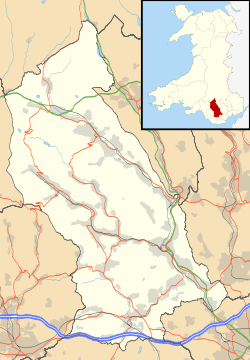Llanharan House
Llanharan House is a historic house on the outskirts of Llanharan, Rhondda Cynon Taf, Wales. It is located off the A473 road, just east of Llanharan and is a Grade II* listed building.[1]
| Llanharan House | |
|---|---|
Llanharan House | |
 Location within Rhondda Cynon Taf | |
| General information | |
| Architectural style | Neo-classical regency |
| Town or city | Llanharan, Rhondda Cynon Taf |
| Country | Wales |
| Coordinates | 51°32′19″N 3°25′54″W |
| Completed | 1750 |
History
The house was built in 1750 by Rees Powell and stayed with the Powell family until 1795 upon which it was purchased by Richard Hoare Jenkins. Hoare Jenkins was a High Sheriff of Glamorgan who was involved in the suppression of the Merthyr Rising of 1831 and is recorded as stating that he found the execution of Dic Penderyn the most difficult of his civic duties. Around 1800 some major improvements were made to the house with the addition of a three-storey circular stair hall which includes a dramatic geometrical staircase.[2] Following the death of Hoare Jenkins in 1856 the house and the estate was passed to a Colonel John Blandy-Jenkins. Following his death in 1915 Colonel Blandy-Jenkins's wife kept the house until 1953, after which it was bought by Sir George Williams CBE MC, of the Williams family of Aberpergwm.

Llanharan house has a strong historical connection with fox hunting. This Welsh pack was named The Llanharan and was established by Richard Hoare Jenkins in 1805, though the pack was renamed the Llangeinor during the period when Mr John Blandy Jenkins was the squire.[3]
The Llangeinor is now based in Coity near Bridgend.
References
- "Llanharan House, Llanharan". British Listed Buildings. Retrieved 15 January 2014.
- Glamorgan County History, Volume VI, Glamorgan Society 1780-1980; Prys Morgan, University of Wales Press, Cardiff (1988)pg. 402
- Foxhounds of Great Britain and Ireland and their Masters and Huntsmen, written by Sir Humphrey F. de Trafford, published in 1905.